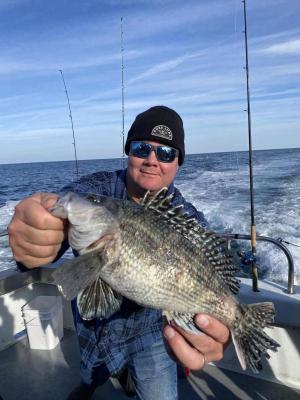Wow! Did I get blindsided Nov. 30 at the Advisory Council on Summer Flounder, Black Sea Bass and Scup meeting. I had prepared a statement requesting the same size and bag limits for black sea bass with an extension of the season into January because with the water staying warmer, the fish remain closer to shore in the winter, and if charter and head boats want to stay in the water, they could fish for sea bass as well as tog.
Then I find out the monitoring committee has developed two new methods for determining the recreational regulations. The one they decided to use for 2023 is called the harvest control rule. It compares the Recreational Harvest Limit with the Marine Recreational Information Program. It determines if the RHL for the upcoming management period is above, below or within the confidence interval of the most recent MRIP time-series estimate.
Step two compares the biomass estimate from the stock assessment to the biomass target level. Biomass target levels are: 150%, above target; between 150% and 100% on target; less than 100%, below the biomass target. The RHL and biomass comparison determines the percent changes needed in harvest levels (if any). Finally, management changes are made to either restrict, liberalize or maintain the regulations to comply with the results of step three.
My understanding of this rule should have given us a more liberal black sea bass season. Somewhere in their calculations we ended up with a 10% decrease. Since the black sea bass biomass is 2.5 times the amount needed for a healthy stock, I could not understand how in the world anyone could say we had to cut our catch by 10%. It was not only me. Every member of the Advisory Council that spoke to this subject agreed that the idea of cutting the black sea bass RCL was absurd. One member from New York said when he tries to fish for fluke (summer flounder) he can’t get a bait to the bottom because the black sea bass grab it before a fluke gets a chance.
There were several regulations mentioned to cut the catch by 10%. One was a 17-inch minimum size. I said if you do that, you will put every charter and head boat in Delaware out of business.
The Mid-Atlantic Council and the Atlantic Marine Fisheries Commission will meet in Annapolis Tuesday, Dec. 13, and I plan to be there. There is no mention in the agenda of a time for public input, but if I have a chance to speak, you can bet I will.
Dinks and dogs
On Monday, I went fishing on the Angler out of Ocean City, Md. I was up at 3:30 a.m. and on the road by 4:30. The drive down is lovely since most of the traffic lights are green and traffic is very light.
Boarding is by reservation number and I was number 30. The mate carried my cooler and tackle bag to the starboard bow. I managed to find a seat at one of the two tables and enjoyed the two-hour ride out in comfort.
Once on the grounds, the first drop produced a run of smooth dog sharks. I only caught one, but some of the better shark fishermen had several throughout the day.
What I did catch were a lot of were small black sea bass. The action was not exactly drop and crank. But when we would hit a school of fish, the bite was steady. Since most of the fish were under the 13-inch minimum size, they went back in the ocean.
There must have been a big number of even smaller fish down there because I would get a series of bites but no hook ups. Then no bites. This was an indication I was now fishing on credit. Cranking the rig back to the surface would reveal two empty hooks.
There were a group of Amish men fishing on the port side of the bow. They only fished for flounder during the entire trip. They used two bucktails baited with Gulp! and I only saw them catch one fish. It was a nice one at 5.5 pounds.
This was certainly a change from back in the 1970s when I worked on a charter and our Amish customers kept everything that came over the rail. Skates, sharks, whatever. Said they fed the trash fish to their pigs.
This trip once again proved just how many black sea bass there are in the ocean. This was Dec. 5, and we have been fishing on them since May 15. Still, I was able to cull out six keepers from all the dinks. I am sure some of my fellow anglers had more and some had fewer.
That’s fishing.




















































